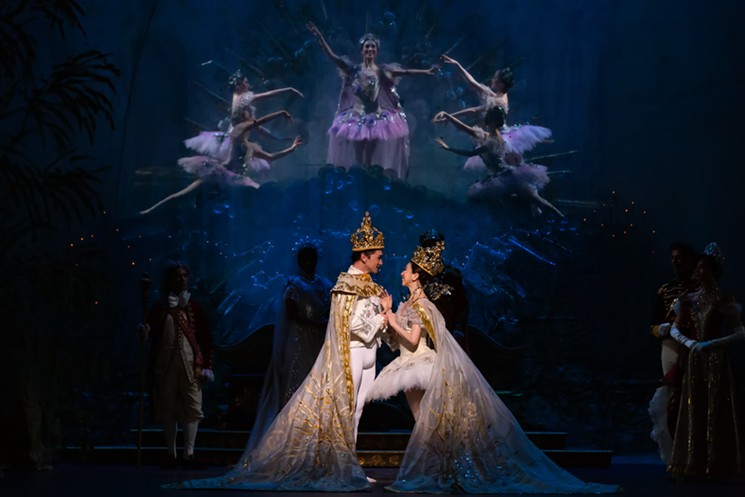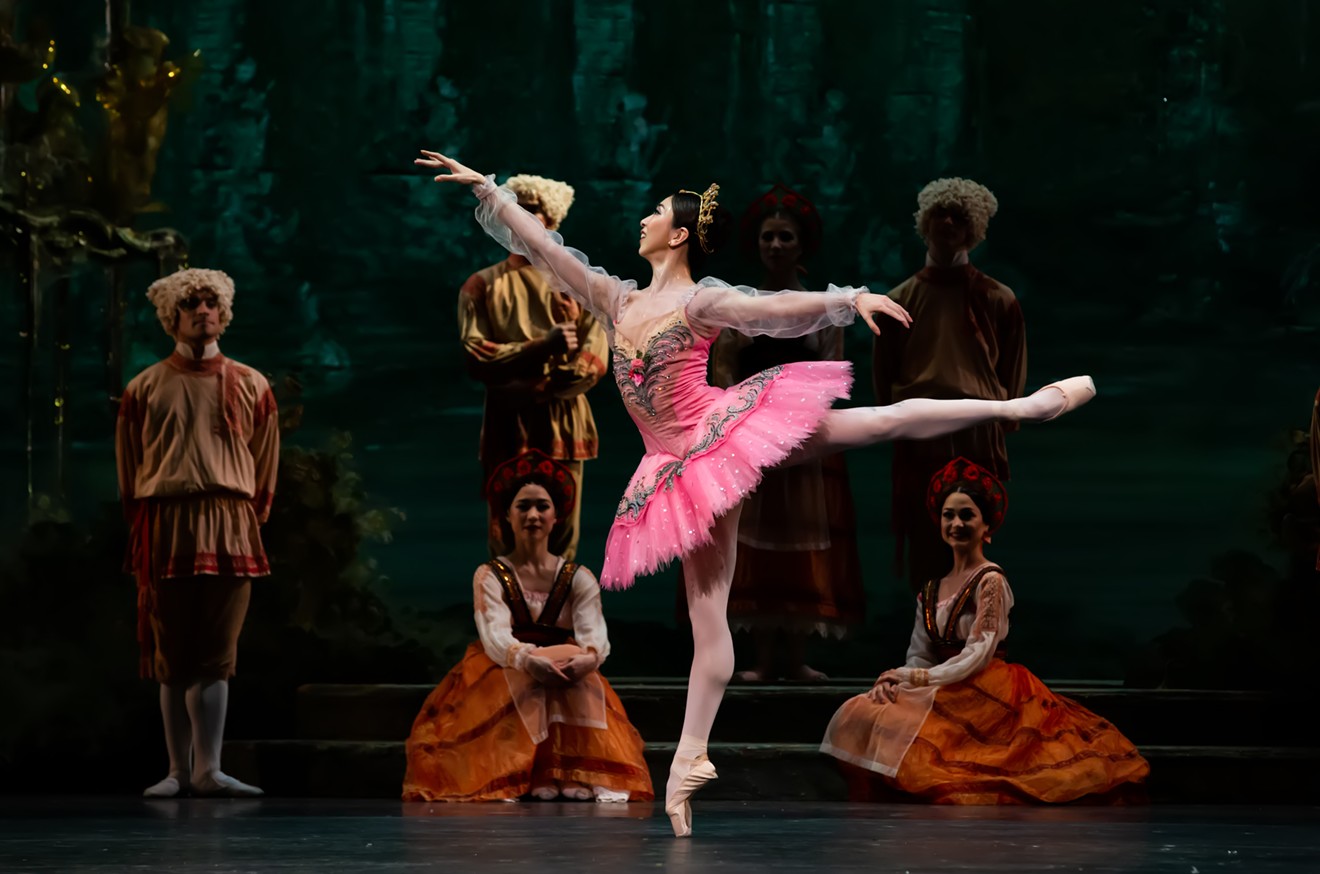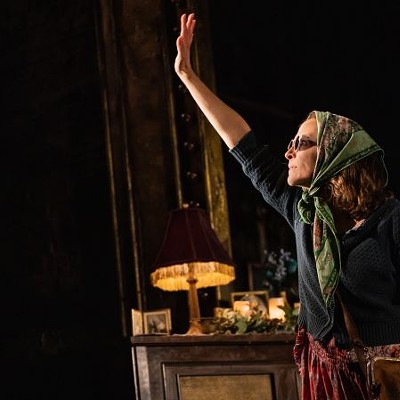“Once upon a time …”
It’s a phrase that can inspire an immediate return to the wide-eyed wonder of childhood, a phrase that immediately readies you for travel to magical, far-off lands. It’s also a phrase that begins Charles Perrault’s “The Sleeping Beauty in the Wood,” which (you can probably guess by the title) was adapted by two greats, Marius Petipa and Pyotr Ilyich Tchaikovsky in 1890, and re-envisioned by another one of the greats, Ben Stevenson. It’s The Sleeping Beauty, now being staged by Houston Ballet.
The “once upon a time” of The Sleeping Beauty begins at a christening. Among the guests for the christening of Princess Aurora are six fairies, each set to bestow a gift on the baby. Someone, however, was left off the guest list, a fairy named Carabosse, and she is none too happy about it. She crashes the party in disguise and curses Aurora, saying that she will grow to be beautiful, but she will prick her finger and die. The saving grace (literally in this case) comes in the form of the Lilac Fairy, the last fairy, interrupted by Carabosse before giving Aurora a gift. The Lilac Fairy alters the curse, promising that Aurora will instead sleep for 100 years’ time, at which point a prince can end the curse with a kiss. Sixteen years later, the inevitable happens and Aurora falls into an extended nap, along with everyone else at the palace, to await a prince’s arrival. But Carabosse is not about to let it go that easy.
If there’s one thing that can be said, or in this case, not said, about Stevenson’s The Sleeping Beauty, it is never let it be said that he didn’t give you something to look at. Despite the simple story being stretched out over a prologue and three acts, or maybe because of, a comfortingly familiar story is enhanced by a lot of good character moments, made all the better by Stevenson’s eye for composition and staging. The care Stevenson took with these characters is clear, and it starts with Princess Aurora.
Despite being an infant in one act and slumbering through another, Yuriko Kajiya’s Princess Aurora is the delightful, bright pink thread that holds this production together. Kajiya is the picture of girlish grace, perfect poise – and let’s talk about the control she displays during the much anticipated Rose Adagio, the sequence where Aurora is introduced to four potential suitors, balanced on pointe – one single pointe – and spun around. Kajiya handles those attitude promenades like a rock star, and examples of her exquisite pointe work pop up again during her pas de deux with Charles-Louis Yoshiyama’s Prince Florimund.
Yoshiyama plays Aurora’s stately prince, who we meet pensively walking the periphery of his hunting party before being lured by Aurora’s beautiful visage (courtesy of the Lilac Fairy) into rescuing her. Yoshiyama’s Florimund looks absolutely enchanted by Aurora, adding greatly to the romance of the third act’s pas de deux, the highlight of which is a crowd-pleasing sequence of three fish dives, one after the other. And in a solo turn, Yoshiyama relentlessly (and dizzyingly) travels around the stage and hits new heights.
The Lilac Fairy and Carabosse, danced by Soo Youn Cho and Melody Mennite, are the two sides of the good/evil coin. Cho is an endlessly reassuring presence as the Lilac Fairy and a confident dancer. Mennite brings real depth to the aggrieved fairy, looking in one moment genuinely hurt and in another quite happy for the chance to terrorize the court. (She’s also got quite the strut on pointe.)
 Much of the rest of the company is put to good use in supporting roles. To start, it would be a crime not to mention the other five fairies, specifically Alyssa Springer’s beautifully long lines, Tyler Donatelli’s chirpy feet, and Allison Miller’s airy pep. The all-too-brief explosion of joy Mónica Gómez brought to the stage, and Jacquelyn Long’s dramatic precision.
Much of the rest of the company is put to good use in supporting roles. To start, it would be a crime not to mention the other five fairies, specifically Alyssa Springer’s beautifully long lines, Tyler Donatelli’s chirpy feet, and Allison Miller’s airy pep. The all-too-brief explosion of joy Mónica Gómez brought to the stage, and Jacquelyn Long’s dramatic precision.
In the third act, a bit of the Mother Goose universe arrives at Aurora and Florimund’s wedding, making for some interesting divertissements, especially that of The White Cat (Natalie Varnum) and Puss-in-Boots (Joshua Guillemot-Rodgerson), who dance a fickle feline pas de deux littered with what else but pas de chat. Also during the wedding festivities is a captivating Pas de Quatre (Aoi Fujiwara, Chae Eun Yang, Chandler Dalton and Harper Watters). Fujiwara and Yang both dance sprightly solos, while Dalton and Watters match each other well when they perform together.
Aesthetically, with his blue feathers and dramatic makeup, Christopher Gray catches the eye as The Bluebird, and he keeps the attention on himself with a series of entrechats and a lot of time spent in the air. And the Ivans (Fernando Martin-Gullans, Hayden Stark and Elivelton Tomazi), with their big gestures and obvious physicality, make for an exciting section too.
I recently made mention of Desmond Heeley’s backdrops and costumes, which totaled around $757,000 when the production premiered back in 1990 – and worth every penny. Heeley’s blue-tinged sets, textured and full of depth, are straight-out-of-a-storybook sophisticated, with lovely set pieces, such as the towering fountain in the first act and the golden, gauzy bed in the second. The original lighting designs by Duane Schuler, recreated here by Lisa J. Pinkham, perfectly illuminate every little detail of Heeley’s work. And you’ll want to take in every detail of the sets and costumes, especially Carabosse’s severe black dress and her tendrilled attendants. One complaint, regarding the costumes, is that the decadent court costumes of the Prologue threaten to overwhelm the performers and it’s distracting.
In case you need to be reminded, The Sleeping Beauty is the second of Tchaikovsky’s trifecta of powerhouse ballets – the others being, of course, Swan Lake and The Nutcracker. And though this isn’t a competition, The Sleeping Beauty tends to come in third in most people’s minds, as it doesn’t epitomize the art form the way Swan Lake does, nor has it racked up the sheer number of spins that The Nutcracker has. But don’t let that trick you into thinking that Tchaikovsky’s score is in any way lacking. The Sleeping Beauty boasts a grand soundscape, performed by the Houston Ballet Orchestra under the direction of Ermanno Florio, which ranges from thrilling epic to pastoral sweetness and is full of musical goodies for the audience. Particularly noteworthy are the gorgeously dreamy harp cadenza that leads into the Rose Adagio; Carabosse’s startling, grotesque motif and the soothing strains that accompany the Lilac Fairy; and an early Act I waltz with a melody that will tickle any “Once Upon a Dream” fan.
Clocking in at three hours, The Sleeping Beauty is admittedly a commitment, one which suffers from a couple of lulls. (The most egregious is during the second act, between the Rose Adagio and the return of Carabosse, during which time absolutely nothing happens.) Though not perfect (and really, what is), it is undeniable that Stevenson’s The Sleeping Beauty is a timeless spectacle, a storybook come to life but better. Better, obviously, because of all the dancing.
It’s a phrase that can inspire an immediate return to the wide-eyed wonder of childhood, a phrase that immediately readies you for travel to magical, far-off lands. It’s also a phrase that begins Charles Perrault’s “The Sleeping Beauty in the Wood,” which (you can probably guess by the title) was adapted by two greats, Marius Petipa and Pyotr Ilyich Tchaikovsky in 1890, and re-envisioned by another one of the greats, Ben Stevenson. It’s The Sleeping Beauty, now being staged by Houston Ballet.
The “once upon a time” of The Sleeping Beauty begins at a christening. Among the guests for the christening of Princess Aurora are six fairies, each set to bestow a gift on the baby. Someone, however, was left off the guest list, a fairy named Carabosse, and she is none too happy about it. She crashes the party in disguise and curses Aurora, saying that she will grow to be beautiful, but she will prick her finger and die. The saving grace (literally in this case) comes in the form of the Lilac Fairy, the last fairy, interrupted by Carabosse before giving Aurora a gift. The Lilac Fairy alters the curse, promising that Aurora will instead sleep for 100 years’ time, at which point a prince can end the curse with a kiss. Sixteen years later, the inevitable happens and Aurora falls into an extended nap, along with everyone else at the palace, to await a prince’s arrival. But Carabosse is not about to let it go that easy.
If there’s one thing that can be said, or in this case, not said, about Stevenson’s The Sleeping Beauty, it is never let it be said that he didn’t give you something to look at. Despite the simple story being stretched out over a prologue and three acts, or maybe because of, a comfortingly familiar story is enhanced by a lot of good character moments, made all the better by Stevenson’s eye for composition and staging. The care Stevenson took with these characters is clear, and it starts with Princess Aurora.
Despite being an infant in one act and slumbering through another, Yuriko Kajiya’s Princess Aurora is the delightful, bright pink thread that holds this production together. Kajiya is the picture of girlish grace, perfect poise – and let’s talk about the control she displays during the much anticipated Rose Adagio, the sequence where Aurora is introduced to four potential suitors, balanced on pointe – one single pointe – and spun around. Kajiya handles those attitude promenades like a rock star, and examples of her exquisite pointe work pop up again during her pas de deux with Charles-Louis Yoshiyama’s Prince Florimund.
Yoshiyama plays Aurora’s stately prince, who we meet pensively walking the periphery of his hunting party before being lured by Aurora’s beautiful visage (courtesy of the Lilac Fairy) into rescuing her. Yoshiyama’s Florimund looks absolutely enchanted by Aurora, adding greatly to the romance of the third act’s pas de deux, the highlight of which is a crowd-pleasing sequence of three fish dives, one after the other. And in a solo turn, Yoshiyama relentlessly (and dizzyingly) travels around the stage and hits new heights.
The Lilac Fairy and Carabosse, danced by Soo Youn Cho and Melody Mennite, are the two sides of the good/evil coin. Cho is an endlessly reassuring presence as the Lilac Fairy and a confident dancer. Mennite brings real depth to the aggrieved fairy, looking in one moment genuinely hurt and in another quite happy for the chance to terrorize the court. (She’s also got quite the strut on pointe.)

Houston Ballet Principals Yuriko Kajiya as Princess Aurora and Charles-Louis Yoshiyama as Prince Florimund with Artists of Houston Ballet and Students of Houston Ballet Academy in Ben Stevenson’s The Sleeping Beauty.
Photo by Amitava Sarkar, Courtesy of Houston Ballet
In the third act, a bit of the Mother Goose universe arrives at Aurora and Florimund’s wedding, making for some interesting divertissements, especially that of The White Cat (Natalie Varnum) and Puss-in-Boots (Joshua Guillemot-Rodgerson), who dance a fickle feline pas de deux littered with what else but pas de chat. Also during the wedding festivities is a captivating Pas de Quatre (Aoi Fujiwara, Chae Eun Yang, Chandler Dalton and Harper Watters). Fujiwara and Yang both dance sprightly solos, while Dalton and Watters match each other well when they perform together.
Aesthetically, with his blue feathers and dramatic makeup, Christopher Gray catches the eye as The Bluebird, and he keeps the attention on himself with a series of entrechats and a lot of time spent in the air. And the Ivans (Fernando Martin-Gullans, Hayden Stark and Elivelton Tomazi), with their big gestures and obvious physicality, make for an exciting section too.
I recently made mention of Desmond Heeley’s backdrops and costumes, which totaled around $757,000 when the production premiered back in 1990 – and worth every penny. Heeley’s blue-tinged sets, textured and full of depth, are straight-out-of-a-storybook sophisticated, with lovely set pieces, such as the towering fountain in the first act and the golden, gauzy bed in the second. The original lighting designs by Duane Schuler, recreated here by Lisa J. Pinkham, perfectly illuminate every little detail of Heeley’s work. And you’ll want to take in every detail of the sets and costumes, especially Carabosse’s severe black dress and her tendrilled attendants. One complaint, regarding the costumes, is that the decadent court costumes of the Prologue threaten to overwhelm the performers and it’s distracting.
In case you need to be reminded, The Sleeping Beauty is the second of Tchaikovsky’s trifecta of powerhouse ballets – the others being, of course, Swan Lake and The Nutcracker. And though this isn’t a competition, The Sleeping Beauty tends to come in third in most people’s minds, as it doesn’t epitomize the art form the way Swan Lake does, nor has it racked up the sheer number of spins that The Nutcracker has. But don’t let that trick you into thinking that Tchaikovsky’s score is in any way lacking. The Sleeping Beauty boasts a grand soundscape, performed by the Houston Ballet Orchestra under the direction of Ermanno Florio, which ranges from thrilling epic to pastoral sweetness and is full of musical goodies for the audience. Particularly noteworthy are the gorgeously dreamy harp cadenza that leads into the Rose Adagio; Carabosse’s startling, grotesque motif and the soothing strains that accompany the Lilac Fairy; and an early Act I waltz with a melody that will tickle any “Once Upon a Dream” fan.
Clocking in at three hours, The Sleeping Beauty is admittedly a commitment, one which suffers from a couple of lulls. (The most egregious is during the second act, between the Rose Adagio and the return of Carabosse, during which time absolutely nothing happens.) Though not perfect (and really, what is), it is undeniable that Stevenson’s The Sleeping Beauty is a timeless spectacle, a storybook come to life but better. Better, obviously, because of all the dancing.
Performances of The Sleeping Beauty continue at 7:30 p.m. Thursday through Saturday, 1:30 p.m. Saturdays and 2 p.m. Sundays at the Wortham Theater Center, 500 Texas. Through March 8. For more information, call 713-227-2787 or visit houstonballet.org. $25 to $200.







